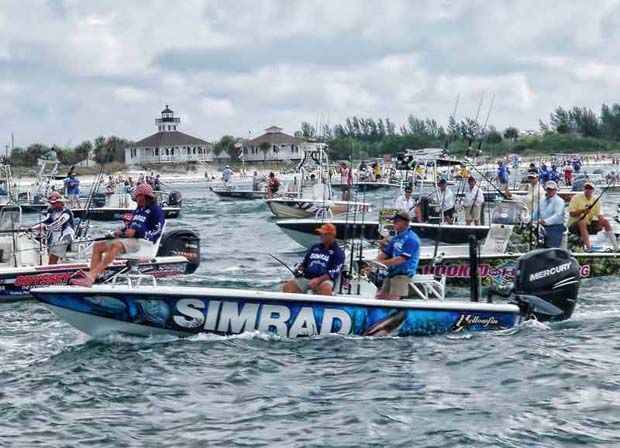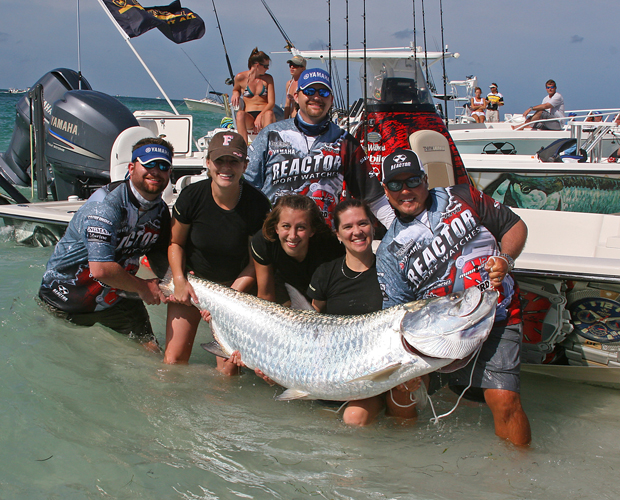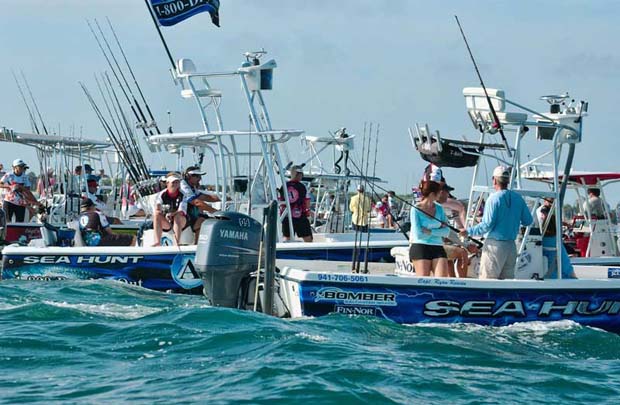Boca Grande, Florida is considered by many to be the tarpon capital of the world, but lately a gang of thugs has decided to destroy the fishery (see image below). Too, they use outlaw jigging rigs so they can snag the tarpon in their Professional Tarpon Tournament Series (PTTS). The PTTS that is destroying Boca Grande Pass fishery is run by Joe Mercurio. Joe is a smart guy who knows how to work a room full of dull minded folks – get them to believing their “RIGHTS” are being taken away from them if sport-less jigging is band. Joe is bent on nothing more than making money.
BY MARCY SHORTUSE
[dropcap]O[/dropcap]n Thursday, Sept. 5 the Florida Fish and Wildlife Conservation Commission will make a decision that will impact Boca Grande tarpon fishing enormously. The proposal on the table, which was discussed at the FWC’s last meeting, is in part regarding the possibility of banning the Boca Grande jig. One organization of some influence in Florida, Bonefish & Tarpon Trust, has weighed in on the issue just prior to the September meeting in Pensacola, where a final decision will be made.
“Bonefish & Tarpon Trust supports the proposed new rules that would ban the Boca Grande Jig,” said Aaron Adams, Director of Operations at BTT.
The commission will decide at the September hearing how to refine the two-part proposal that would include the definition of “snagging” and the modification of gear used in the Pass.
According to the FWC, “The proposal adds language that prohibits catching or attempting to catch tarpon that have not been attracted or enticed by the angler’s gear to the snagging definition that applies statewide. This change would apply to tarpon fishing statewide. The second part of the proposal would prohibit fishing with gear that has a weight attached to the bottom of a hook. This change would apply to fishing for all species year-round within Boca Grande Pass.”
Currently live bait fishermen using traditional fishing methods in the Pass do not use bottom-weighted jigs (often referred to as the “Boca Grande jig”). Others, such as anglers in the Professional Tarpon Tournament Series, do use them … frequently. The debate that has raged on for years in the Pass is this: Is a bottom-weighted hook a snagging device?
In 2002-2004 FWC scientists conducted a study in the Pass, examining fish caught by both live bait and jig fishermen. At that time FWC researcher results showed that there was little difference in the mortality rate or the snagging rate between tarpon caught with live bait and those with jigs. However, the two scientists contacted to give their opinions in the study, Dr. Phillip Motta and Dr. Justin Grubich (two of the leading fish researchers in the world), have said that their opinions given in that study were not correct, and that they were not given enough information to make an informed and complete decision.
Since then, the people of Boca Grande and several conservation groups have said they witness more dead tarpon washing up on shore after some of the tournaments held in the Pass every year, in which many of the anglers use the bottom-weighted jig.
Nick Wiley, the president of the Florida Wildlife Research Institute, said he believes it’s time to change some FWC rules, and said after all of the testimony they have heard, as well as after taking a close look at the equipment, his organization is not happy with how the jig is fished.
“I feel there was plenty of evidence that this jig could result in a snagging situation,” he said at the June meeting.
The agenda for the September meeting shows that the jigging and snagging issue is at the top of the agenda for the first day of the conference.
68B-32.002 states that the proposed final rule would enhance the definition in the tarpon chapter of “snagging” or “snatch hooking.” The second part of the proposal, 68B-4.018, Boca Grande Pass Gear Restrictions states, “The proposed final rule would prohibit the use and possession of gear rigged with a weight attached to the bottom of the hook in Boca Grande Pass.”
A vote to pursue refining these definitions was passed with a 4-3 vote by commissioners at the last meeting.
The following is text from the BTT press release by Aaron Adams
The Boca Grande Pass – Charlotte Harbor estuary is a unique place, and is an essential location for the regional tarpon population
[dropcap]A[/dropcap]dult tarpon gather in both pre-spawn and post-spawn groups in Boca Grande Pass and Charlotte Harbor. The Pass provides a unique biophysical feature that provides special advantage to tarpon during their spawning process – a deep place to gather in inshore protected waters. The adjacent estuary is also unique in that it is one of the biologically richest in the region, providing abundant prey for large numbers of adult tarpon during spawning season. Satellite tracking data show that some of the tarpon that gather in Boca Grande Pass and Charlotte Harbor migrate seasonally, supporting the recreational fishery from the Mississippi River to the southeastern coast as far north as Chesapeake Bay.
Charlotte Harbor is also an important tarpon nursery. Oceanographic currents carry tarpon larvae from the likely offshore spawning locations to the extensive mangrove wetlands of Charlotte Harbor and southwest Florida, further increasing the importance of this location for the region’s tarpon population.
Much has been made of the fact that: 1) catch rates have not changed with the advent of the vertical fishing method with the Boca Grande Jig; 2) that the number of tarpon caught or snagged with the Boca Grande Jig was too small to cause a negative impact to the tarpon population. Both of these suppositions are problematic.
First, when applied to fishes that occur in groups, catch rates often provide inaccurate measures of population size and fishery health. More worrisome, they can provide misleading information that leads to overfishing. This is explained by the phenomenon of hyperstability. In effect, the overall catch rate can remain relatively stable even as total abundance declines because the total number of fish that can be captured is not correlated with the abundance of fish.
For example, the maximum catch rate of tarpon might be two tarpon per boat per hour, which will remain unchanged even as the abundance of tarpon in an aggregation can decline from 100,000 to 10,000. However, such a massive decline in abundance is clearly cause for concern. By the time the catch rate declines, the damage has been done and recovery will be a long, slow process.
Second, because Boca Grande Pass is an important pre- and post-spawning location, it is not the number of fish snagged/caught that is of primary concern.
The measure of concern should be how the fishing method alters tarpon behavior. Considerable research has been conducted on the complex behaviors often associated with fish spawning, with successful spawning dependent upon successful execution of these behaviors. Interruption of such behavior has potential negative consequences for spawning success. The concern in Boca Grande Pass is that the vertical jigging method is altering tarpon behavior in the pre-spawning aggregations. In the ‘traditional’ method of fishing in the Pass, boats drift with the tide, presenting bait or lures to tarpon that are in the pathway of the drift. This allows tarpon that are not going to eat, or are in a pre-spawning behavior mode, to refuse the bait/lure, which continues to drift down-current.
The tarpon can remain in position within the aggregation. In contrast, the vertical jigging method entails using the boat motor to maintain boat position over a tarpon aggregation (the school of tarpon is recorded on Fish Finders), with multiple jigs lowered into the group of tarpon. This removes the ability of tarpon to reject the jig and remain in place. Instead, the tarpon must change location to avoid the jig, possibly interrupting behavior. Such behavior alteration may have deleterious population-level effects.
Other states have already realized and addressed the impact of snagging and associated angling methods in similar situations. For example, salmon on spawning runs or on spawning beds are susceptible to snagging and behavior-altering fishing methods. Implementation of bans on snagging gear and methods has resulted in improved fishing and increased fish abundance, with positive effects at the population level.
Lest we consider tarpon conservation as overkill, a recent international assessment of tarpon suggests a cautious approach to their management is required. The recent assessment classified tarpon as Vulnerable due to habitat loss and degradation, declines in water quality, and harvest in parts of its range. The Vulnerable status means that the population has declined at least 30% in the recent past and/or is expected to decline in the near future. Commercial fishing in the Caribbean and Gulf of Mexico caused a major population crash in the 1960s and 1970s, and ongoing issues threaten a future population decline.
Because of its importance as a pre- and post-spawning aggregation site, Boca Grande Pass requires application of the precautionary principal. When the health of the fishery is in question, it is imperative to error on the side of the fish and enact conservation-oriented measures. In conjunction with the catch and release regulations recently passed by the Florida Fish and Wildlife Conservation Commission, which in part address angler behavior in Boca Grande Pass (e.g., prohibiting dragging tarpon after capture), the proposed changes to Boca Grande Pass regulations should decrease post-release mortality and allow tarpon to revert to previous behavior patterns, which should have positive implications for the regional tarpon population.
For more information on Dr. Grubich’s testimony regarding his involvement in the original study, Click here […]






